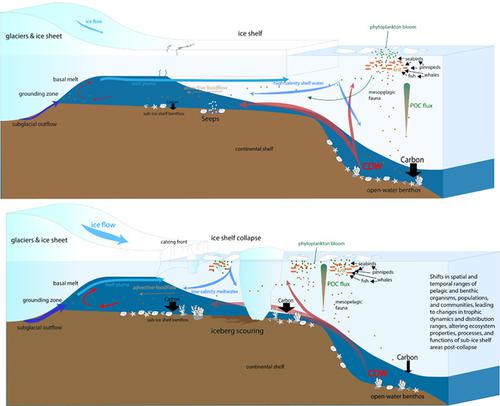当前位置:
X-MOL 学术
›
WIREs Clim. Chang.
›
论文详情
Our official English website, www.x-mol.net, welcomes your
feedback! (Note: you will need to create a separate account there.)
Antarctic ecosystem responses following ice‐shelf collapse and iceberg calving: Science review and future research
WIREs Climate Change ( IF 9.4 ) Pub Date : 2020-10-05 , DOI: 10.1002/wcc.682 Jeroen Ingels 1 , Richard B. Aronson 2 , Craig R. Smith 3 , Amy Baco 4 , Holly M. Bik 5 , James A. Blake 6 , Angelika Brandt 7, 8 , Mattias Cape 9 , David Demaster 10 , Emily Dolan 1 , Eugene Domack 11 , Spencer Fire 2 , Heidi Geisz 1 , Michael Gigliotti 2 , Huw Griffiths 12 , Kenneth M. Halanych 13 , Charlotte Havermans 14, 15 , Falk Huettmann 16 , Scott Ishman 17 , Sven A. Kranz 4 , Amy Leventer 18 , Andrew R. Mahon 19 , James McClintock 20 , Michael L. McCormick 21 , B. Greg Mitchell 22 , Alison E. Murray 23 , Lloyd Peck 12 , Alex Rogers 24 , Barbara Shoplock 1 , Kathryn E. Smith 25 , Brittan Steffel 2 , Michael R. Stukel 4 , Andrew K. Sweetman 26 , Michelle Taylor 27 , Andrew R. Thurber 28 , Martin Truffer 16 , Anton Putte 29 , Ann Vanreusel 30 , Maria Angelica Zamora‐Duran 2
WIREs Climate Change ( IF 9.4 ) Pub Date : 2020-10-05 , DOI: 10.1002/wcc.682 Jeroen Ingels 1 , Richard B. Aronson 2 , Craig R. Smith 3 , Amy Baco 4 , Holly M. Bik 5 , James A. Blake 6 , Angelika Brandt 7, 8 , Mattias Cape 9 , David Demaster 10 , Emily Dolan 1 , Eugene Domack 11 , Spencer Fire 2 , Heidi Geisz 1 , Michael Gigliotti 2 , Huw Griffiths 12 , Kenneth M. Halanych 13 , Charlotte Havermans 14, 15 , Falk Huettmann 16 , Scott Ishman 17 , Sven A. Kranz 4 , Amy Leventer 18 , Andrew R. Mahon 19 , James McClintock 20 , Michael L. McCormick 21 , B. Greg Mitchell 22 , Alison E. Murray 23 , Lloyd Peck 12 , Alex Rogers 24 , Barbara Shoplock 1 , Kathryn E. Smith 25 , Brittan Steffel 2 , Michael R. Stukel 4 , Andrew K. Sweetman 26 , Michelle Taylor 27 , Andrew R. Thurber 28 , Martin Truffer 16 , Anton Putte 29 , Ann Vanreusel 30 , Maria Angelica Zamora‐Duran 2
Affiliation

|
The calving of A‐68, the 5,800‐km2, 1‐trillion‐ton iceberg shed from the Larsen C Ice Shelf in July 2017, is one of over 10 significant ice‐shelf loss events in the past few decades resulting from rapid warming around the Antarctic Peninsula. The rapid thinning, retreat, and collapse of ice shelves along the Antarctic Peninsula are harbingers of warming effects around the entire continent. Ice shelves cover more than 1.5 million km2 and fringe 75% of Antarctica's coastline, delineating the primary connections between the Antarctic continent, the continental ice, and the Southern Ocean. Changes in Antarctic ice shelves bring dramatic and large‐scale modifications to Southern Ocean ecosystems and continental ice movements, with global‐scale implications. The thinning and rate of future ice‐shelf demise is notoriously unpredictable, but models suggest increased shelf‐melt and calving will become more common. To date, little is known about sub‐ice‐shelf ecosystems, and our understanding of ecosystem change following collapse and calving is predominantly based on responsive science once collapses have occurred. In this review, we outline what is known about (a) ice‐shelf melt, volume loss, retreat, and calving, (b) ice‐shelf‐associated ecosystems through sub‐ice, sediment‐core, and pre‐collapse and post‐collapse studies, and (c) ecological responses in pelagic, sympagic, and benthic ecosystems. We then discuss major knowledge gaps and how science might address these gaps.
中文翻译:

冰架坍塌和冰山崩塌后的南极生态系统响应:科学评论和未来研究
2017年7月从Larsen C冰架上掉下的5,800 km 2、1万亿吨冰山中的A-68产犊,是过去几十年来由于迅速变暖导致的10多次重大冰架损失事件之一在南极半岛周围。南极半岛冰架的迅速变薄,后退和坍塌,是整个大陆变暖影响的预兆。冰架覆盖超过150万公里2和南极海岸线的75%边缘,描绘了南极大陆,大陆冰与南大洋之间的主要联系。南极冰架的变化给南大洋的生态系统和大陆冰运动带来了巨大的,大规模的变化,具有全球范围的意义。众所周知,未来冰架消亡的变薄和速度是不可预测的,但是模型表明,架子融化的增加和产犊将变得更加普遍。迄今为止,人们对冰架以下生态系统知之甚少,而我们对崩溃和产犊后生态系统变化的理解主要基于一旦崩溃发生后的响应科学。在这篇评论中,我们概述了有关(a)冰架融化,体积损失,后退和产犊的知识,(b)通过子冰层与冰架相关的生态系统,沉积物核心,崩塌前和崩塌后研究,以及(c)中上层,共生和底栖生态系统的生态响应。然后,我们讨论主要的知识差距以及科学如何解决这些差距。
更新日期:2020-10-05
中文翻译:

冰架坍塌和冰山崩塌后的南极生态系统响应:科学评论和未来研究
2017年7月从Larsen C冰架上掉下的5,800 km 2、1万亿吨冰山中的A-68产犊,是过去几十年来由于迅速变暖导致的10多次重大冰架损失事件之一在南极半岛周围。南极半岛冰架的迅速变薄,后退和坍塌,是整个大陆变暖影响的预兆。冰架覆盖超过150万公里2和南极海岸线的75%边缘,描绘了南极大陆,大陆冰与南大洋之间的主要联系。南极冰架的变化给南大洋的生态系统和大陆冰运动带来了巨大的,大规模的变化,具有全球范围的意义。众所周知,未来冰架消亡的变薄和速度是不可预测的,但是模型表明,架子融化的增加和产犊将变得更加普遍。迄今为止,人们对冰架以下生态系统知之甚少,而我们对崩溃和产犊后生态系统变化的理解主要基于一旦崩溃发生后的响应科学。在这篇评论中,我们概述了有关(a)冰架融化,体积损失,后退和产犊的知识,(b)通过子冰层与冰架相关的生态系统,沉积物核心,崩塌前和崩塌后研究,以及(c)中上层,共生和底栖生态系统的生态响应。然后,我们讨论主要的知识差距以及科学如何解决这些差距。











































 京公网安备 11010802027423号
京公网安备 11010802027423号